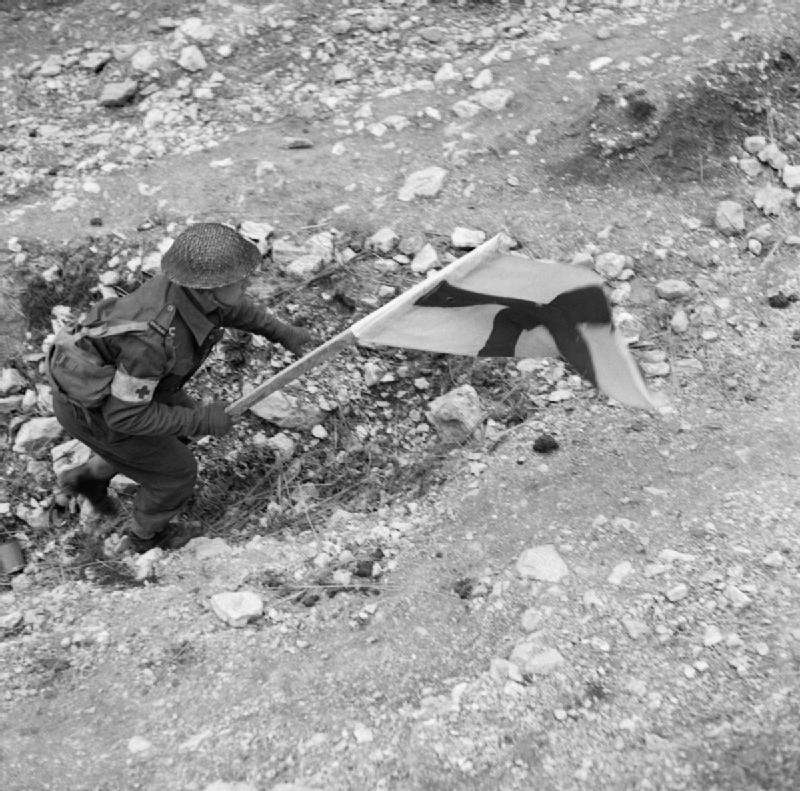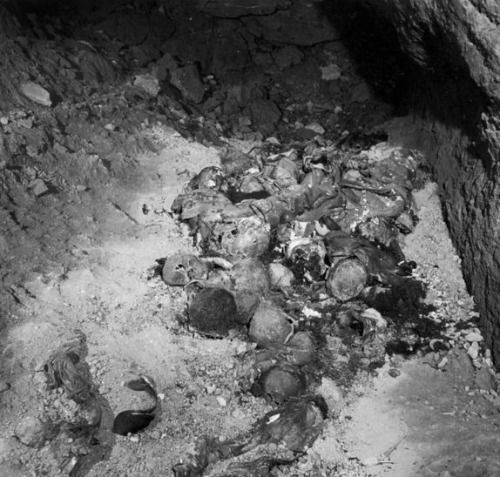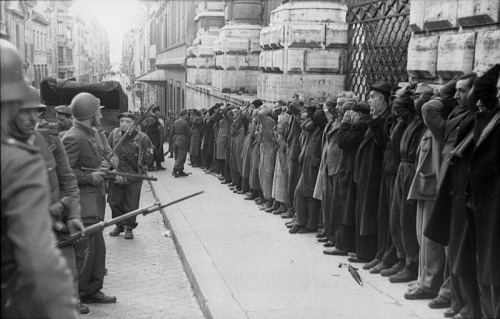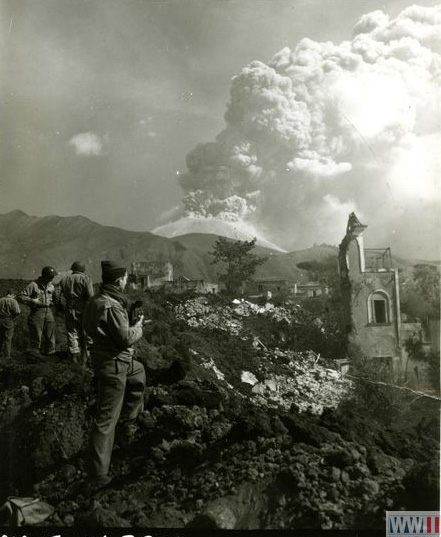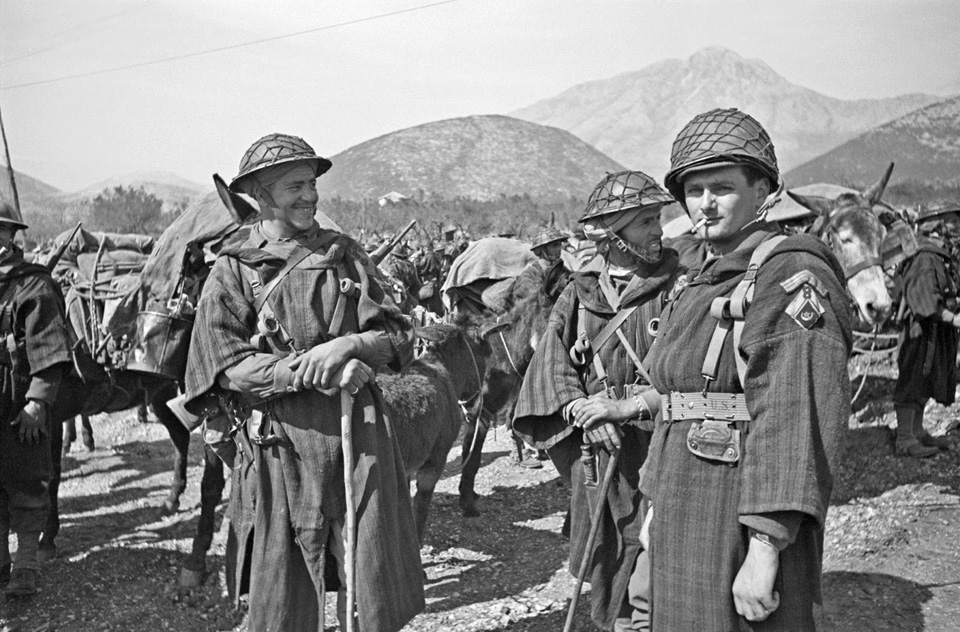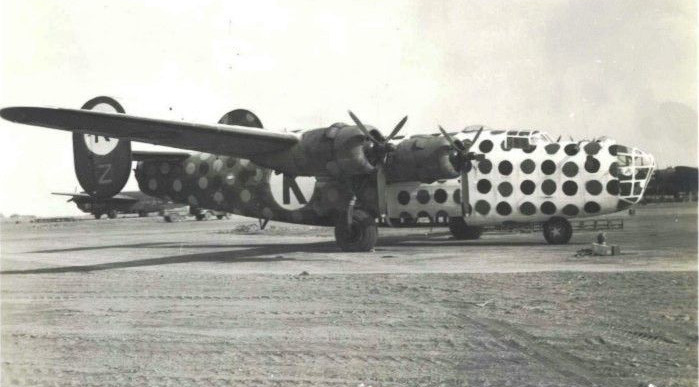Admiralty Islands
Following a short artillery preparation the 1st Squadron, 5th Cavalry and 2nd Squadron, 12th Cavalry, advance westwards, taking several hills held by the Japanese. Here, too, this is the last engagement of any size, though the mopping up operations continue for a long time. The Japanese Imperial Headquarters has already realized that it is only possible to carry out rearguard actions along the furthest defensive perimeter of their South Pacific empire, and that the Allied threat is now to the central Pacific, where they will have to concentrate all their available forces.
[Air Operations, Carolines
41st Medium Bomb Group B-25s attack Ant and Ponape islands.
[Air Operations, CBI
BURMA- 12 7th Heavy Bomb Group B-24s and 10 459th Fighter Squadron P-38 fighter-bombers attack a dump at Pyingaing near Mandalay. 9 490th Medium Bomb Squadron B-25s attack a factory and rail facilities at Shwebo. More than 50 10th Air Force A-31s attack Homalin and Thamanthi. 8 P-51 fighter-bombers attack the viaduct at Gokteik. 4 P-40s attack Japanese Army ground positions at Shaduzup.
Air Operations, Europe
RAF BOMBER COMMANDBattle of Berlin
Evening Ops:
- 811 planes are sent to Berlin including 577 Lancasters, 216 Halifaxes and 18 Mosquitos. 53 aircraft are forced to abort.
- The time over the target is 22:25-22:45. 2,493 tons of bombs are dropped including 1,070 tons of high explosives and 1,423 tons of incendiaries.
- 44 Lancasters and 28 Halifaxes are lost on the raid. Aircrew casualties are 392 killed, 131 POWs and 4 evaders.
- In supporting operations are 147 planes from training units sweeping across northern France, 11 Mosquitos 'spoof' raid at Kiel, 19 Oboe Mosquitos on night fighters fields in Holland, Belgium and France and 19 Serrate Mosquitos on Intruder patrols. 17 aircraft are involved in other operations with no losses.
- 1 Serrate Mosquito is lost.
- The main force takes off mid-evening. The wind out of the north turns out to be a long stronger that predicted. The navigators in the bombers doubt their calculations because of the wind strength. The night becomes known in Bomber Command as the 'night of the strong winds'. The bombers arrive at the Dutch coast well scattered and there the planes are given further inaccurate wind forecasts. Many try to correct their courses based upon their more accurate findings. As a result, the bomber stream never regains its concentration. Arriving over Berlin more than 700 aircraft are spread out over a frontage of at least 70 miles. The Berlin Flak and searchlights remain quiet and many aircraft fly past the city. Some begin orbiting the city waiting for the target time. The Aiming Point is at the eastern end of the Tiergarten with the intention of hitting the areas north and east of the city center. The Pathfinders are scattered just like the main force. The Target Indicators and Skymarkers blow rapidly across the target. The bomb loads are dropped somewhere.
- A total of 126 communities outside of Berlin report bombs, mostly in the fields and woods outside the city. In the city 86 buildings are destroyed, 1,483 report damage. 30 people are killed and 141 injured. It is estimated that maybe half the bombs fall in Berlin, but every part of the city is hit from the very northern suburbs to the extreme south about 20 miles away. There are two areas of concentration, Horst Wessel in the north and a large area south and southwest of the center.
- On the return flight the bombers are scattered over a frontage of more than 50 miles with the length of the stream being about 150 miles. About 740 planes emerge from the target area. 19 planes are shot down on the first 60 miles of the return route. A total of 56 bombers come down on the return flight from Berlin to the Dutch coast. 1 planes goes down in the sea, 2 crash in England and 1 ditches in a coastal minefield.
- During the raid Flt-Sgt Nicholas Alkemade jumps, without a parachute, from a blazing RAF Lancaster 5,486 m (18,000 ft) above western Germany and lands safely in a snow drift.
- Bomber Command totals for the Battle of Berlin in the 19 raids on the city include 10,813 planes dispatched with 9,560 reaching the target area. 33,390 tons of bombs have been dropped which include 17,214 tons of high explosive and 16,176 tons of incendiaries. Among the bomb totals are 6,811 4,000-pound 'Blockbusters' and 53 of the even bigger 8,000-pounders. The number of aircraft lost on the Berlin raids is 7% of Bomber Command's total wartime losses. 2,690 aircrew are killed in these raids.
FRANCE:
- 148 2nd Bomb Division B-24s attack the St.-Dizier/Robinson Airdrome, and 33 B-24s diverting from the Metz/Frescati Airdrome because of cloud cover attack the Nancy/Essay Airdrome. Escort is provided by two P-47 groups.
- 60 1st Bomb Division B-17s attack the primary target, Schweinfurt, with 130 tons of bombs. 162 B-17s attack the secondary, Frankfurt am Main, with 382 tons of bombs.
- There are no losses to enemy action, but 11 crewmen and 8 servicemen and 2 children on the ground are killed when a pathfinder B-17 crashes during a pre-mission flight. 2 B-17s crash after colliding near Schweinfurt.
- Escort is provided by nearly 450 fighters from nine groups.
- 4 fighters and 3 of their pilots are lost in two separate mid-air collisions.
ITALY:
- 12th Air Force B-26s attack the rail line and a bridge at Orvieto.
- 12th Air Force B-26s attack port facilities at Leghorn, and bivouac areas and supply dumps.
- XII Air Support Command A-20s attack gun emplacements near Cassino.
- XII Air Support Command A-36s and P-40s attack gun emplacements, troop concentrations, and road targets in the Cassino battle area.
- XII Air Support Command P-47s attack a train and a rail bridge near Rome.
ITALY:
- Under relentless attack as part of Operation STRANGLE, the rail lines to Rme from northern Italy are completely severed following week-long attacks by the 12th and 15th Air Forces. Hereafter, until the city is liberated in June, no rail car is able to get through Rome in any direction.
- Although more than 200 15th Air Force B-17s and B-24s abort in the face of bad weather, approximately 100 B-24s attack a marshalling yard at Rimini, and 32 B-24s attack Ancona, Senigallia, and several rail and road bridges spanning the Vomano River.
Air Operations, Japan
3 28th Composite Bomb Group B-24s complete a photo-reconnaissance mission over Onnekotan Island in the Kurile Islands.
[Air Operations, New Guinea
1 V Bomber Command B-24 attacks Sek Island. V Fighter Command P-39 and P-40 dive-bombers attack Alexishafen.
[+
Bougainville
The Japanese try to extend their penetration into the American Cape Torokina beachhead, but an American counterattack drives them back with heavy losses. This is to be the last large-scale action by the Japanese in the Solomon Islands, though sporadic skirmishes go on until May. The perimeter of the beachhead will be slightly extended.
[CBI
BURMABritish Maj-Gen Orde Wingate, the legendary leader of the Chindits, is killed in an air crash while flying from Imphal to Lalaghat. He was 41. He had organized the Chindits and was a leading proponent of irregular warfare. The Senior Chindit brigade commander, Brig Walter Lentaigne, replaces him. To avert the enemy threat on the central front, preparations are being made to bring in the XXXIII Corps and commit it in the Dimapur-Kohima area, to the north of the IV Corps. The British 2nd Division begins to move to this region.
In the NCAC area, the US 5307th Unis attempts to envelop Inkangahtawng but finds it too strongly held. The Japanese strongly oppose efforts to block the Kamaing Road in this region. In the skirmishes that follow, 200 Japanese troops are killed while the Marauders suffer 15 casualties. Learning that an enemy force is moving to outflank them, the 2nd Battalion withdraw to the Manpin area. The 3rd Battalion then pulls back to Ngahgahtawng to bivouac.
[Eastern Front
The advance of 1st Ukraine Front continues at speed. Chertkov and Zaleschik are taken in the drive southeast of Tarnopol. 3rd Ukraine Front takes Voznesensk northeast of Nikolayev.
SOUTHERN SECTORAfter a difficult advance the 1st Tank Army reaches the Dniestr River at Zaleschik, severing Hube's westward escape route. After establishing a bridgehead, the 1st pushes on toward Kolomna and Chernovitsy. The 40th Army of the 2nd Ukrainian Front reaches the Prut River near Lipkany. Proskurov falls to the 1st Ukrainian Front while the 1st Guards Army repulses a renewed German relief attack toward Tarnopol and attacks Group Neinhoff inside the town.
[Germany, Home Front
The Great Escape. 76 Allied airmen escape from Stalag Luft III near Sagan during the night using a 365-ft tunnel. 50 are recaptured and murdered.
[India
The British begin to assemble forces, namely the XXXIII Corps preceded by the British 2nd Div, in the area of Kohima, north of Imphal in case the IV Corps, deployed in defense of Imphal, should give way.
[Italy
The Germans execute 335 civilians, including many Jews, at the Ardeatine caves near Rome as a reprisal for an attack by partisans that resulted in the death of 32 German soldiers.
[Pacific
- The Japanese submarine I-32 is sunk by the US destroyer escort Manlove (DE-36) and the submarine chaser PC-1135 in the Marshall Islands area.
- The US submarine Bowfin (SS-287) attacks a Japanese convoy about 15 miles off the south coast of Mindanao about 95 miles south of Davao and sinks the transport Shinkyo Maru (5139t) and the army cargo ship Bengal Maru (5399t).
Solomons
The last significant Japanese effort on Bougainville comes to an end. There are various small skirmishes for a few months but the Japanese are worn out and the Americans are content merely to watch the Japanese weakness. In the past couple of weeks the Japanese have lost about 8,000 casualties, the Americans only 300.
[Images from March 24, 1944
|
|
|
|
|
|
